
This article is for personal and business tax preparation. Here are some simple tips for tax breaks that will save you money.
Know the worth of charitable contributions.
According to CPA and Vice President of TurboTax Bob Meighan, many taxpayers underestimate their contributions to charity. Some of the items that are commonly overlooked include mileage, out-of-pocket expenses and the value of used goods. Although you cannot deduct the value of the time you spend volunteering, you can claim a tax break for mileage incurred while driving to and from your volunteer location. You simply keep a record of how many miles you drive for each charitable purpose and multiply by the millage rate set by the IRS which is currently 14 cents per mile. Another potential deductible expense is out-of-pocket expenses incurred while volunteering. The IRS also allows you to deduct the fair market value of items that you donate to charities such as clothing, furniture, toys and other used goods. TurboTax offers a free site called ItsDeductible, which allows users to determine the value of thousands of items based on the price they draw on eBay. For example, a book worth $7 on the site would amount to a deduction of $1.75 if you are in the 25% tax bracket. To claim this type of deduction, you should catalog each contribution with a detailed list of donated items and their prices.
More details can be found in IRS Publication 526, Charitable Contributions.
Take Advantage of retirement savings.
Contributions to retirement accounts made by low-and moderate-income taxpayers are usually untaxed and may even get a credit to reduce their tax liability by up to $1000. Examples of qualifying retirement accounts include IRAs, Roth IRAs, 401ks and 403bs.
More details can be found in IRS publication 4703, Retirement Savings Contribution Credit.
Deduct medical expenses.
Medical expenses in surplus of 7.5% of your AGI can qualify for write-offs in 2012. Taxpayers under the age of 65 can claim up to 10% for tax year 2013. Programs such as weight-loss and smoking-cessation programs can be counted toward the total as well as out-of-pocket doctor visits, hospital stays and prescription drugs. The distance traveled to and from medical treatment can also be a write-off at 23 cents per mile. Other transportation costs such as tolls and parking also apply.
More details can be found in the IRS Publication 502, Medical and Dental Expenses.
Write off your move.
Expenses incurred while job-searching can be deductible if they exceed 2% of your AGI. In addition, you are entitled to a tax break if your new job requires you to relocate. The moving expense tax break is considered an “above the line” deduction because you don’t have to itemize to claim it. It is entered as an adjustment to income. In order to qualify for this break, the new workplace must be at least 50 miles away from your previous home, and you have to work at least 39 weeks during the 12 months following your new job location. However, if you are a member of the armed forces and ordered to permanently change stations, you don’t have to meet the distance and time requirements.
More details can be found in the IRS publication 521, Moving Expenses.
Recuperate from disaster.
Many Americans are underinsured for catastrophes so events such as hurricanes, flood or house fires can leave victims facing huge bills. However, the government offers the chance to write off the expenses associated with such events. If you are insured, you must file a claim. Any expense that is reimbursed by the insurance company cannot be deducted but those costs that are not covered can be claimed as a casualty loss. If the disaster was federally declared, you can amend the previous year’s tax return to include the loss which allows you to receive a refund in the same year as the disaster.
More details can found in IRS Publication 547, Casualty Losses.
Receive credit for working.
For low and moderate-income families, there is a credit incentive to work. In some cases, taxpayers from lower income families can get money back even if they do not owe any federal taxes. The credits range from $475 for childless families to $5891 for families with three or more children. To qualify for these credits in 2012, the family’s total adjusted gross income must fall below the maximum amounts listed below:
– No children – the AGI limit is $13,980 for singles and $19,190 for couples.
-One qualifying child – the AIG limit is $36,920 for singles and $42,130 for couples.
-Two qualifying children – the AIG limit is $41,952 for singles and $47,162 for couples.
-More than two qualifying children – the AGI limit is $45,060 for singles and $50,270 for couples.
More details can be found in the IRS publication 596, Earned Income Credit.
Get assistance with education costs.
Both credits and deductions can apply to the costs of higher education, but it is important to choose wisely because only one of these options can be used. The American Opportunity Tax Credit, which is available to undergraduate students, can reduce your taxes by as much as $2500. This credit applies to all educational expenses such as tuition, books, materials and supplies. The Lifetime Learning Credit offers a break of up to $2000 per tax return for full-time and part-time graduate and undergraduate students. Even if you do not qualify for either credit, you may be able to deduct up to $4000 if your AGI is less than $80,000 for singles and $160,000 for a married couples filing a joint return.
More details can be found in Publication 970, Tax Benefits for Education.
If own a small business, our experienced tax professionals can help you effectively handle all of your business tax issues. For more information about our full range of business tax and accounting services, visit us today at www.businesstaxpreparation.com. Contact us by phone at (866) 676-9417 or by email at info@businestaxpreparation.com to receive a free, no obligation consultation.
